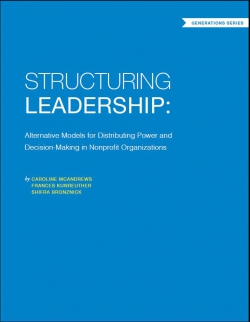Structuring Leadership: Alternative Models for Distributing Power and Decision-making
For the past twenty years the Building Movement Project has addressed leadership in the nonprofit sector by focusing on generational shifts, multigenerational leadership, and new ways of leading. In each of these areas, the question we are most often asked by younger generations is whether we can provide them with new models of how to run/lead organizations that do not concentrate authority and responsibility in one top person. We believe these models exist but they are either unrecognized or embedded within traditional-looking hierarchies. We also believe that highlighting different leadership structures will offer organizations examples for effective ways to operate that can increase impact.
In Structuring Leadership: Alternative Models for Distributing Power and Decision-making in Nonprofit Organizations, written by Caroline McAndrews, Frances Kunreuther, and Shifra Bronznick, we set out to identify and document these models with a focus on increasing organizational impact. Our interest was to find operating structures that address potential barriers to effectiveness, including the growing demands on executives running nonprofits, the current realities of a multigenerational workforce where older leaders will stay longer, and the expectations and work style of new generations coming into the workplace with a strong team orientation. Research, demand and anecdotal evidence points to the need to lift up new ideas for leading organizations, but nonprofit examples have not been systematically documented.
What we identified was less alternative organizational charts and more foundational work and practices that promote different leadership structures. The foundations – trust, learning, values, and time – are key in developing healthy and productive work environments. Practices such as embracing autonomy, creating buy-in from staff and board members, sharing information, clarifying roles and letting go of control could be taught and reinforced in leadership training including with boards of directors. Finally, the point of sharing leadership is to have more success in our work, both internally and externally.

